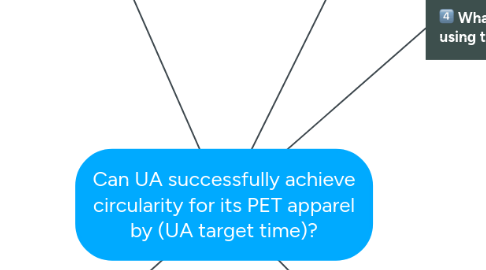
1. What is the status of recycling of PET/polyester fiber?
1.1. Who is playing what roles within the ecosystem?
1.2. How well is PET recycle working today?
1.2.1. What's working/not working (e.g., limited fiber recycle)?
1.2.2. What hinders performance?
1.2.3. What's missing?
1.2.4. What are threats?
1.2.5. What ate opportunities?
1.3. What is the importance of recycle today and in the future?
1.4. What are regional differences?
2. Situation
2.1. UA is a major sportswear brand owner that uses significant quantities of polyester-based materials. A strategic focus is for UA to shift to 100%polyester based fibers in their products.
2.2. UA is seeking competitive advantage in an environment where global polyester markets are expected to transition toward to circularity.
2.3. UA is in a JV with IBM research, and Technip. Technology is VolCat (selective digestion) produces high-purity BHET from mixed polyester recycle materials.
2.3.1. Other Partners? (e.g., Milliken)
2.3.2. Discussions with other participants? (e.g., Indorama and DAK?)
2.4. Multiple options for path from VolCat technology to UA circularity
2.4.1. License technology
2.4.2. Produce PET chips
2.4.3. Recycle PET chips to recycle fiber
2.4.4. Recycle fiber to UA apparel
2.5. UA is seeking IHSM's assistance to provide polyester market insights to evaluate alternatives aligned with UA's objectives.
2.5.1. Understand landscape and possibilities
2.5.2. Achieve circularity via VolCat technology
3. Complications
3.1. UA objectives may not be aligned with its partners with respect to VolCat. UA wishes to explore opportunities for PET fiber (vs, licensing technology selling equipment). (Need validation)
3.2. Minimal post consumer PET fiber is recycled today. Presents infrastructure and business challenges for acquisition of PET fiber for recycle. Represents possible opportunity for first mover advantage.
3.3. VolCat product is BHET (i.e., not a commercially traded product today). Will require additional investment.
3.4. Convenient and consistent feedstocks for the VolCat process (e.g., dirty bottles, recycled textiles).
3.5. Polyester producers are fragmented and the circular chain is long and complicated.
4. What is the current situation of PET globally?
4.1. What are key attributes of the industry?
4.1.1. Market size, growth
4.1.2. Key trends and drivers
4.1.3. Applications
4.1.4. Supply/Demand Balances
4.1.5. Capacity
4.2. What is PET value chain structure?
4.2.1. Raw material (TPA + MEG)
4.2.2. Potential intermediate BHET
4.2.3. PET chips (merchant and integrated) and virgin or recycle
4.2.4. PET fiber (virgin or recycle)
4.2.5. Mass balance accounting for recycle streams
4.3. Who are the industry participants?
4.3.1. What is th degree of integration through the value chain?
4.3.2. Regional differences?
4.3.3. UA competitors or potential partners?
5. Assumptions
5.1. VolCat technology works.
5.2. VolCat technology can be scaled.
5.3. UA's goal is to achieve x% circularity for PET apparel by (2030? 2040?) (Need clarification.)
6. What are the attributes of UA and the broader PET/ polyester fiber ecosystem when UA achieves x% circularity?
6.1. What must be addressed to create robust circular value chain for PET apparel?
6.2. What is the impact of (IHSM) scenarios (e.g., work backwards from Net Zero)?
6.3. What has to change, and over what time period?
6.4. When does UA achieve X% circularity?
6.4.1. What are the interim targets?
7. What are the implications of using the VolCat technology?
7.1. What are PET recycle pathways?
7.1.1. Mechanical Recycle
7.1.2. Chemical Recycle
7.2. What are required inputs?
7.2.1. PET Bottles
7.2.2. PET Fiber / Facric
7.3. What is the availability of required inputs?
7.4. What is the required BHET product quality?
7.5. Are changes to existing processes necessary for broad adoption?
7.6. What investments are required?
8. DRAFT - CONFIDENTIAL
9. What is UA's roadmap to acheive x % circularity by 20XX?
9.1. What are preferred region(s)?
9.2. What are the preferred entry vehicles?
9.3. Who are the preferred partners (i.e., at company level)?
9.3.1. Existing VolCat partners
9.3.2. New
9.4. What roles do partners/participants have to play?
9.5. What investments will UA need to make?
9.5.1. What role(s) will UA (have to) play?
9.5.1.1. Traditional
9.5.1.2. New
9.6. When will UA achieve circularity?
9.6.1. What are key milestones?
